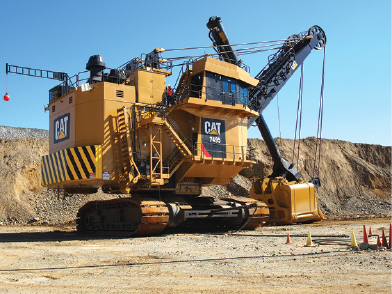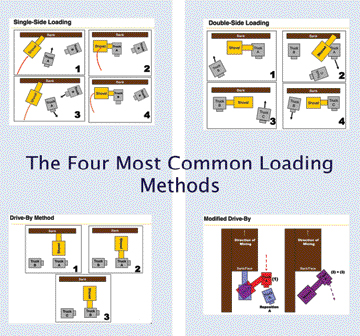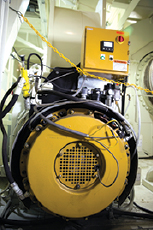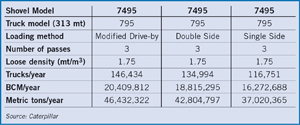The latest options, often employing new technologies, range from hoist braking to HydraCrowd, and e-room air filtration to onsite power generation.
By Russell A. Carter, Managing Editor
 |
| Cat’s rope shovel range covers dipper payload capacities from 20 tons to the 90- to 120-ton capacity of its 7495 models, one of which is shown here. The two smallest models—the 182M and 42-ton 295HD—are available only in India. |
Since the finalization of its purchase of Bucyrus International more than 2.5 years ago, Caterpillar has been working steadily, in an increasingly dismal global equipment sales environment, to accommodate the new product lines, parts and maintenance network arrangements, and even corporate cultural differences that came with the $8.8 billion acquisition.
In autumn 2013, Cat’s Global Mining division invited customers to its Tinaja Hills, Arizona, demonstration and learning center to catch up on recent developments in the company’s rope and hydraulic shovel lineup, accompanied by similar briefings on its mine truck and mining-class loader models. Cat equipment specialists provided general selection criteria and application guidelines for making correct equipment choices—and once purchased, for using them most effectively.
Seven Shovels
Cat now offers seven electric rope shovel models, ranging from the 20-ton-payload 182M and 42-ton 295HD to the 90-ton 7495HD and the 120-ton 7495/7495HF. The 182M and the 295HD are only sold in India through a partnership with a local manufacturer, and they are the only rope shovels without the “7” nomenclature prefix that Cat has assigned to all other models incorporated from the former Bucyrus shovel range. In between the smallest models and the ultra-class 7495 units are the 50-ton 7295 and 70-ton 7395, both classified by Cat as sub-ultra class shovels.
Obviously, none of these machines are inexpensive, explained Cat’s Jeff Klingel, lifecycle cost manager for electric rope shovels, but if the customer has a world-class deposit and can afford the upfront cost, electric rope shovels provide the lowest loading-related cost per ton. They have an extremely long operating life, averaging 20 years but not infrequently reaching 25 years and beyond. Their typical availability, at more than 90%, is exceptional for loading tools, and because the hoist cycle ends with the dipper above the truck body, cycle times are efficient, commonly in the 30- to 36-second range. In addition, the shovel operator sits at a level above the haul-truck body, providing high visibility and safety. Dipper fill factors range from 95% to 110%, struck.
Electric rope shovels require a reliable, clean source of power to operate, and until recently, this meant power from the grid; however, Cat has developed an off-grid power solution, and demonstrated the system at the Tinaja Hills event (more on that later). To operate efficiently, shovels also need a high face height. As Klingel explained, a rope shovel’s digging action is different from hydraulic shovels; they cut from the bottom to the top of the face in an arc-shaped loading profile. Sub-ultra class shovels need a face height of at least 33 ft for efficient dipper loading, while ultra-class models need much more—in the range of 50 ft or so. Even so, their front-end configuration provides additional operating benefits derived from the large working radius from the face and from nearby haul trucks. These include good visibility for double-sided truck loading and easier truck spotting. In addition, the wide working radius keeps the operator far from the face, improving overall safety.
Factors to examine when considering a shovel’s potential cost per ton fall into two categories: cost and productivity.
 |
| The HydraCrowd system, shown here, uses a massive, tube-enclosed hydraulic cylinder to reduce stress on a shovel’s front-end components, replacing maintenance-heavy cable arrangements. |
Cost factors include:
- Capital investment,
- Machine life,
- Fuel or electricity costs,
- Cost of replacement parts (new vs. refurbished),
- Cost of consumable parts,
- Hours to maintain the machine, and
- Local labor rates (operator and maintenance).
Productivity considerations are:
- Loading methods,
- Truck/shovel pass match, and
- Gaps between theoretical and actual tons per hour,
- Skilled truck and shovel operators.
- Shovels properly “trucked.”
There are four primary loading methods: single side, double side, drive-by and modified drive-by. There can be significant productivity differences depending on which method is used and how well it conforms to site conditions and fleet configuration. Each loading method has specific advantages and disadvantages, but as the chart indicates, the modified drive-by method (illustrated in the diagram above) offers the highest potential production rate of all the methods, if the proper site conditions and necessary operator skills are available.
For prospective or even current customers that are unsure about which method would yield the best results, given a specific site’s fleet configuration, terrain, worker experience and other variables, Cat can help in estimating potential productivity, said Klingel. Its senior application engineers have developed an elaborate spreadsheet that takes into account a wide range of loading-related factors and produces an accurate estimate of shovel/truck loading productivity per year for various loading scenarios. Based on input data such as shovel model, truck type and capacity, loading method and dipper capacity, the “Theoretical Production Estimate” spreadsheet supplies an appraisal of maximum annual production capacity for different combinations of the input items. A simplified summary of its results is shown in the chart below.
Selecting the Right Configuration
 |
| Cat’s new Dynamic Hoist Brake is designed to stop the dipper from dropping during an uncontrolled event such as a power drop or an emergency stop. |
Prospective shovel customers also have a number of important decisions to make concerning the actual configuration and pre/post-commissioning support for the shovel. In general, for Cat’s machines these include:
- Electrical system (incoming voltage, frequency, lighting),
- Crowd system (rope vs. HydraCrowd),
- Crawler links (width),
- Altitude package (standard, high, extreme),
- Weather package (extreme; hot +50°C; and cold -20°C or -40°C),
- Dipper size and type (standard vs. LatchFree, liner package and GET),
- Filtration system,
- Air compressor (make),
- Cable couplers (make),
- Support document language,
- Field assembly support, and
- Training.
Some of these decisions could involve features that are relatively new to the market, or may still be in the late stages of Cat’s product testing and introduction program, such as the Power Demand Management System, HydraCrowd crowd system, Cat Air Filtration System and LatchFree dipper. These features were, for the most part, originally conceived by Bucyrus, then carried through and further refined by Cat after the acquisition. The power management system, Hydra-Crowd and LatchFree dipper are currently designated as “limited release” features that are still being evaluated under real-world operating conditions.
With its Power Demand Management System, Cat offers off-the-grid technology that enables mining companies to power a Cat 7495 or 7495 HF electric rope shovel on just 4 MW of generator power, compared with conventional setups that use multiple generators with a total of 8 MW or more capacity to achieve rapid response when peak power is required. In addition to the increase in maintenance and fuel costs associated with a multi-unit generator setup, generator-powered electric rope shovels require additional systems to dissipate regenerated energy because they can’t feed electricity back into the power grid.
Caterpillar’s off-grid power system, however, affords mining operations the opportunity to use electric rope shovels at the onset of production in a greenfield mine, or to quickly move into a new area at an existing mine in which a stable power supply isn’t readily available. And, using ultra-capacitor technology, the off-grid system stores regenerative energy created during swing deceleration and bucket lowering, then uses that power during periods of high demand to reduce the generator load cycle.
The system’s peak-shaving technology also provides power management benefits to mining operations that are operating on an electrical grid. This technology configuration reduces peak power requirements on the power distribution system, allowing rope shovel customers the opportunity to reduce costs with smaller substations. The lower peak power requirements also allow smaller-gauge trail cables, or longer trail cable runs, which can also reduce costs and minimize downtime.
Both the 7495 shovel and Cat’s yet-to-be-released 6120B H FS hydraulic shovel will use the ultra-capacitor technology that is at the core of the power management system.
 The HydraCrowd design was developed to reduce stress on a rope shovel’s front-end components: With any shovel, as the dipper crowds the bank, the handle recoils slightly. On Cat shovels, this force is absorbed in the ropes (rope crowd) or with hydraulic fluid (Hydra-
The HydraCrowd design was developed to reduce stress on a rope shovel’s front-end components: With any shovel, as the dipper crowds the bank, the handle recoils slightly. On Cat shovels, this force is absorbed in the ropes (rope crowd) or with hydraulic fluid (Hydra-
Crowd), reducing stress on the handle. On a rack-and-pinion system, the force is absorbed where the rack and pinions mesh, often leading to broken teeth and increased handle cracking. With HydraCrowd, hydraulic components inside the tubular dipper handle replace a conventional, maintenance-intensive wire rope and gear mechanism, using instead a massive hydraulic cylinder to eliminate the need for crowd/retract rope maintenance and replacement. Offering a two-year major maintenance interval, Cat said HydraCrowd improves safety and cuts downtime by reducing the number of maintenance events needed.
The LatchFree dipper door-locking mechanism is designed to eliminate the conventional latch assembly, replacing it with a steel link mounted to the dipper back, away from material flow.
Cat also is working on a line of ground-engaging tools (GET) specifically for its shovels, but these are not yet market-ready.
However, another new shovel-specific feature that is now commercially available is Cat’s Dynamic Hoist Brake, offered for the 7495 and 7495HF shovels. The hoist brake is designed to stop the dipper from dropping during an uncontrolled event such as a power drop or an emergency stop. The new brake is designed to perform and survive a full speed dynamic brake event with a fully loaded dipper and, as a result, to minimize the risk of an uncontrolled dipper dropping onto a haul truck.
Cat’s Dynamic Hoist Brake is a drop-in replacement for the standard brake, which was designed to be applied when the hoist motor was not rotating. The new brake offers a number of advantages, including friction material that eliminates burnishing requirements and reduces variations in brake torque, increased thermal capacity, increased product life, mechanical wear indication and simplified, on-machine rebuild procedures.
Caterpillar also has developed a Smart Controller, available as an option, to continuously monitor the applied torque, energy input and wear of the Dynamic Hoist Brake. The controller also includes hardware that will apply additional brake torque if necessary via a secondary pneumatic piston.
The Smart Controller helps ensure brake torque levels do not drop below specified levels even as a result of temperature extremes, improper maintenance or other abnormalities. The system also monitors brake energy levels to anticipate thermal overload. It can be fitted to all 7495 and 7495HF shovels using the Cat Dynamic Hoist Brake.
Cat’s Air Filtration System for the big shovels is an improved version of previous Bucyrus systems, incorporating Dynavane filters and other refinements that are claimed to clean the air in electrical rooms 25% better than similar-sized systems, and consequently, extend the life of sensitive electrical components. The system, according to Cat, also simplifies filter changing, eliminates dust buildup on the house roof, and employs nanofiber cartridge filters for longer life and higher efficiency.
Keeping Track of Performance
Once a shovel is on-site and commissioned, the key to cost-effective performance and reliability is information—lots of it. Cat offers a “technology package” for shovels that comprises four services:
- AccessDirect—An Internet-based interface that facilitates remote access to machine’s on-board computer, and permits monitoring, adjustment, resetting, and modification of electrical parameters.
- MIDAS Condition Monitoring—A diagnostic system that helps optimize machine performance by logging and analyzing data on a variety of machine variables.
- Accuload—A data analysis system that provides real-time feedback on dipper load. When used with MIDAS, Accuload data can be logged and analyzed.
- Bearing Temperature Monitoring—A system that monitors hoist, swing, and crowd bearing temperatures and alerts the operator when temperature problems arise.
The four systems can be purchased as a single package or installed individually.









